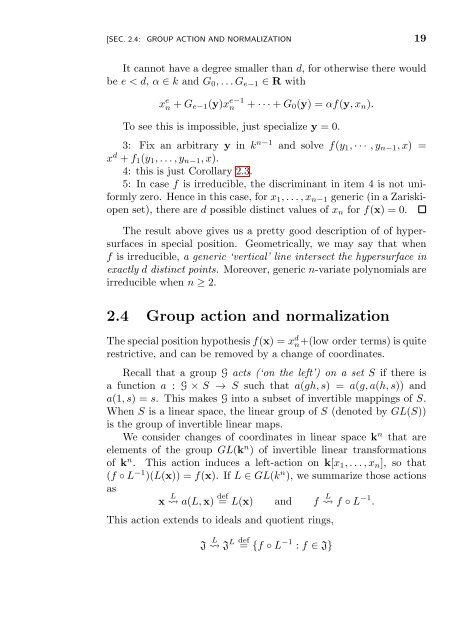Nonlinear Equations - UFRJ
Nonlinear Equations - UFRJ
Nonlinear Equations - UFRJ
You also want an ePaper? Increase the reach of your titles
YUMPU automatically turns print PDFs into web optimized ePapers that Google loves.
[SEC. 2.4: GROUP ACTION AND NORMALIZATION 19<br />
It cannot have a degree smaller than d, for otherwise there would<br />
be e < d, α ∈ k and G 0 , . . . G e−1 ∈ R with<br />
x e n + G e−1 (y)x e−1<br />
n + · · · + G 0 (y) = αf(y, x n ).<br />
To see this is impossible, just specialize y = 0.<br />
3: Fix an arbitrary y in k n−1 and solve f(y 1 , · · · , y n−1 , x) =<br />
x d + f 1 (y 1 , . . . , y n−1 , x).<br />
4: this is just Corollary 2.3.<br />
5: In case f is irreducible, the discriminant in item 4 is not uniformly<br />
zero. Hence in this case, for x 1 , . . . , x n−1 generic (in a Zariskiopen<br />
set), there are d possible distinct values of x n for f(x) = 0.<br />
The result above gives us a pretty good description of of hypersurfaces<br />
in special position. Geometrically, we may say that when<br />
f is irreducible, a generic ‘vertical’ line intersect the hypersurface in<br />
exactly d distinct points. Moreover, generic n-variate polynomials are<br />
irreducible when n ≥ 2.<br />
2.4 Group action and normalization<br />
The special position hypothesis f(x) = x d n+(low order terms) is quite<br />
restrictive, and can be removed by a change of coordinates.<br />
Recall that a group G acts (‘on the left’) on a set S if there is<br />
a function a : G × S → S such that a(gh, s) = a(g, a(h, s)) and<br />
a(1, s) = s. This makes G into a subset of invertible mappings of S.<br />
When S is a linear space, the linear group of S (denoted by GL(S))<br />
is the group of invertible linear maps.<br />
We consider changes of coordinates in linear space k n that are<br />
elements of the group GL(k n ) of invertible linear transformations<br />
of k n . This action induces a left-action on k[x 1 , . . . , x n ], so that<br />
(f ◦ L −1 )(L(x)) = f(x). If L ∈ GL(k n ), we summarize those actions<br />
as<br />
x L a(L, x) def<br />
= L(x) and f L f ◦ L −1 .<br />
This action extends to ideals and quotient rings,<br />
J L J L def<br />
= {f ◦ L −1 : f ∈ J}

















